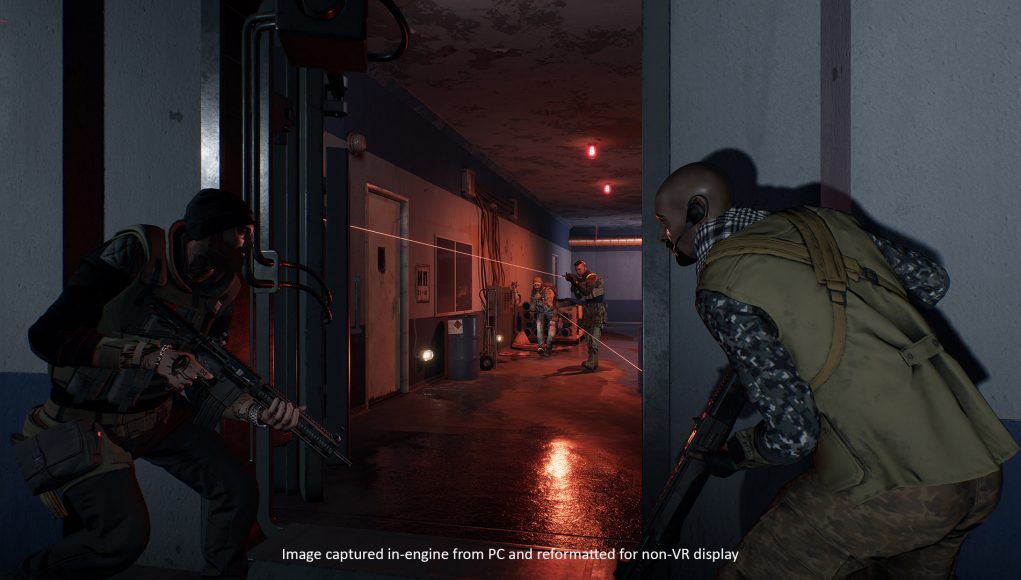Firewall Zero Hour has landed on PSVR, and with it comes the platform’s first tactical multiplayer FPS. While the slow one-life-only pace might not suit everyone’s taste, it makes for undeniably tense and strategic gameplay that’s enhanced by the immersion of VR.
Firewall Zero Hour Review Details:
Publisher: Sony Interactive Entertainment
Developer: First Contact Entertainment
Available On: PlayStation Store (PlayStation VR) [Exclusive]
Reviewed On: PS4 Pro, PS Aim
Release Date: August 28th, 2018
Gameplay
While Firewall Zero Hour has a training mode that’s a simple wave shooter, the game is effectively a multiplayer-only game, which pits two teams of four players against each other. There’s a single game mode which plays out like a mix between a typical death match and an objective match. The attacking team must first activate one of two randomly placed objectives to locate a final objective (a laptop which must be hacked). Hacking the laptop wins the match for the attacking team. It’s up to the defending team, who knows the locations of all the objective from the get-go, to either prevent the attackers from hacking the laptop in the five minute match, or wipe them out completely. The attackers can also wipe out the defending team, and can then hack the laptop uncontested to win the round.
Each player only has one life, so this is absolutely not a run-and-gun game; it will take strategy, tactics, and patience to succeed, both individually and as a team. Fortunately every PSVR is equipped with a mic and it’s enabled by default, letting you start chatting with matched teammates as soon as you join them in the pre-game lobby. If you get shot, you’ll get ‘knocked down’ first, giving your teammates a chance to revive you, but beware that enemies can finish off downed players before that happens, and you can bleed out after not too long.
The game serves up 13 primary weapons which fall into three basic classes: Assault Rifles (for medium-far range), SMGs (short-medium), and Shotguns (close-short). There’s also secondary weapons (pistols), though their utility seems very limited, except in the case where you’ve got a shotgun and need a little more range. The small to medium sized maps at times actually feel quite large for two teams of four, but there’s nothing like a sniper rifle to speak of, so expect to be looking through red dot and holographic scopes with no optical zoom (probably a smart choice considering PSVR’s tracking limitations).
Each weapon also has a solid range of attachments that can be unlocked with the game’s currency after reaching a certain experience level. You’ll find the usual suspects like silencers, compensations, and laser sights, along with some more interesting things like underslung grenade and shotgun attachments. Weapons can be further customized with skins and little tags that hang off the side (called ‘Trinkets’). It seems the game currency is not purchasable with real-life money (and we hope it stays that way).
There’s also equipment to be unlocked like ammo bags, C4, grenades, proximity mines, and more, including a few interesting bits like a ‘Revive Pistol’, which allows you to revive a downed teammate from a distance by shooting a syringe at them; a Noise Maker grenade, which simulates gunfire to draw the attention of enemies; and a Door Blocker, which can block off key entrances.
Shooting generally feels good and works mostly according to known FPS paradigms when it comes to which weapons work best in which situations. The time-to-kill falls into the Call of Duty realm (fast), meaning if you get caught off guard you are likely to go down before having a chance to return fire. Shotguns can kill in one shot at close enough range, and headshots will score bonus damage for those who can stay cool and aim well under pressure. Aiming down sights is essential to hitting and killing enemies, though thanks to having a tracked controller, you can blind fire over cover or around corners which can be useful for suppression but is unlikely to result in any kills.
Mechanically speaking, weapons have modeled recoil and sway which can be controlled by counteracting those movements with your controller. For instance, shooting an SMG at full auto will cause the gun to kick upward, but you can consistently move your controller down to help keep the reticle in place. With a burst-fire assault rifle, on the other hand, at range you’ll need to wait a bit for the reticle to steady after your first burst before you can get in an accurate follow up shot.
Combined with attachments which control these factors, the weapon mechanics feel like they have good depth, meaning players who understand and practice with each weapon will become much more proficient with them in ways that go beyond just putting a red dot over an enemy’s head and spamming the trigger.
As a starting player you have access to three default loadouts, which come equipped with a solid set of attachments and equipment. You’ll have to level up to be able to build your own loadouts, and you’ll have to unlock all the weapons, attachments, and equipment from scratch when building a custom loadout. While we’d hope to see even more weapons and equipment added over time, it feels like there’s enough here at the start to keep players hunting their next item, but some may find the pace of rewards too slow, as most every unlock is hidden behind both an experience level and currency wall. This means that it will take players a handful of hours before they can unlock enough to make just one custom loadout that rivals the default loadouts.
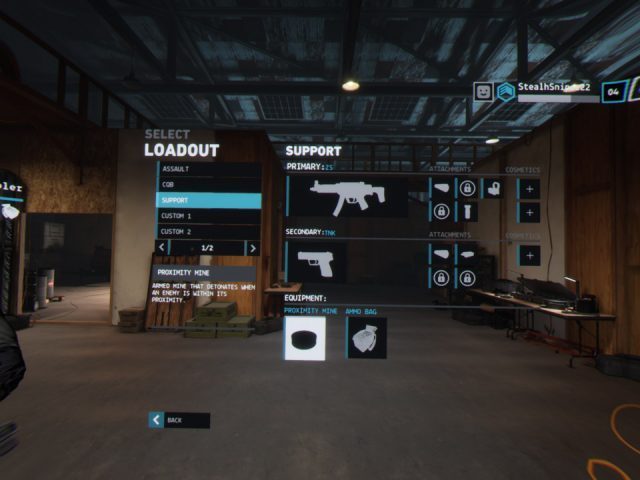
In addition to weapons, players also choose their character type (called Contractors in the game), which can each be equipped with two small perks, like taking reduced explosive damage or being able to be revived faster. Unfortunately these perks feel largely inconsequential, though they could become more important as the game’s ‘meta’ (the way players choose to play against each other) becomes clearer over time.
After hanging out in a lobby where you can choose your loadout, you’ll be dropped into a loading screen during which you unfortunately can’t speak with your teammates, which is a bit of an annoyance when you’re mid conversation. Matches have an extremely short five minute time limit, and often play out much faster than when one team gets eliminated completely. When the match is over, you’ll get kicked back out to the lobby (including another loading screen where you can’t talk to your teammates), and then wait another minute to switch from Attacker to Defender, and/or switch maps before loading back in for the next match.
So it’s roughly up to five minutes of gameplay for every two minutes of downtime, which is a bad ratio, especially for VR. If you die early in the match it’s an even worse trade of gameplay to downtime. This appears to be a significant oversight, and something that First Contact Entertainment will hopefully fix as a top priority. Instead of loading screens and lobby time between every match, a multi-round match structure (perhaps best out of three) would be much better, not only for improving the gameplay to downtime ratio, but also because it would mean a greater commitment when choosing a loadout for the entire match, and a greater sense of accomplishment after being able to best the other team in a tie-breaker round.
Teammates who don’t communicate are almost certain to lose. Not only because strategizing collectively is important to winning, but also because when players die they can rotate through a series of cameras placed around each map, and continue to speak to their teammates, even while dead, to make key callouts about enemy movements.
On one hand, this is a smart idea because it means that players aren’t sitting around doing absolutely nothing when they die (which is even less fun in a VR headset), but on the other hand, this big brother surveillance feels far too powerful for the tactical nature of the game where information about your opponents is a premium commodity. The placement of cameras across each map, and the ability to see and speak to your teammates no matter where they are on the map, means that in many cases it almost seems preferable to have a dead teammate manning the cameras than to have them still alive on your team. It would be nice to see this toned back to make it feel more balanced, starting with making camera positions more visible to players, and giving a visual indication of when they are being operated by teammates and enemies alike.
Firewall Zero Hour uses free locomotion with the left (front) thumbstick, while the right (back) stick does snap rotations. Movement is slow—the default walk is like a slow walk in real life, and “sprint” is like a fast paced walk, while crouch walking is super slow, but also quiet—which contributes to the tactical pace of the game. Still, movement feels a little too slow for my liking, especially because it makes grenades and other explosive more powerful than you might expect, since it’s hard to move out of their way quickly. Though tactics will evolve over time, especially as players unlock more of the game’s equipment, grenade spam is at this point used often and is quite effective, especially as one of the Contractor perks it to get an extra grenade.
While Firewall Zero Hour technically supports the PS4 gamepad, it seems made mostly for the PS Aim controller, especially as all primary weapons are two handed, and all aiming is done by physically looking down the sights of each gun. Using the PS4 gamepad—which gives you a tracked weapon just like Aim—feels awkward by comparison because Aim puts your hands in a much more comfortable position for aiming than the gamepad which is designed to be held symmetrically and at the center of your body, not up near your head and off to one side.
It will take weeks if not months to see how Firewall Zero Hour’s meta evolves, and whether high-level play hits a sweet spot supporting many strategies, playstyles, and loadouts, or if everyone is driven to using mostly the weapons and tactics. This will also depend on First Contact Entertainment’s willingness to support the game in the long-term and ensure that the meta develops in a healthy way that keeps players happy and coming back for more. The fact that Firewall Zero Hour can be said to have a meta at all is a testament to the potential depth of its gameplay, and a good sign for the future.
Immersion
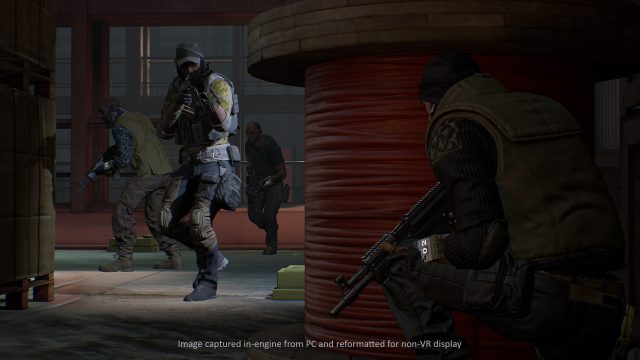
Firewall Zero Hour is a good looking game. First Contact Entertainment has shown their skill as experienced VR developers in achieving a graphically detailed world that performs consistently well.
Having only one life per match inherently amps up the sense of virtual embodiment, as death is much more punishing than in an FPS where you know you’ll respawn just a few seconds later. Grenades flying in your direction, hearing the signature noise of a triggered proximity mine, and seeing an enemy suddenly round an unexpected corner are going to be intense and memorable moments.
Although the weapons are all fictional, they’re clearly based on recognizable weapons from the real world (you’ll immediately see the archetypal M16, AK, and UMP equivalents). They look great across the board, with rich details even when inspecting them up close. Since they look good, they also feel cool to ‘hold’ in your hands, as your controller allows you move them around naturally. This means that personalizing them with attachments, skins, and trinkets is even more rewarding than in a typical non-VR FPS.
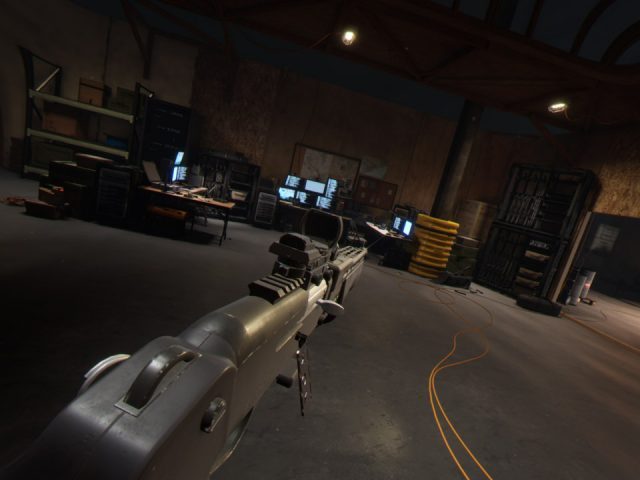
Where Bravo Team (2018) was widely criticized for the poor scale of its first-person components (weapons and arms) and frequently awkward first-person animations (like reloading), Firewall Zero Hour does a much better job. Arms and weapons feel like they’re at the right scale and position, and the procedurally animated reloads look significantly more natural than what was seen from Bravo Team. It’s possible, when holding your controller in a weird position, to make the arms and reloading animations do something that looks strange, but typically it all works well without being distracting.
One thing that still feels a little awkward is grenade throwing. In Firewall Zero Hour, you aim your grenades with a trajectory line that animates out the barrel of your gun, and then when you commit to throwing the grenade, your gun quickly moves away and your character’s arm suddenly appears to throw the grenade. It likely would be less jarring for the arm to appear during aiming, and then complete the throw once the action is initiated, or to simply have all grenades fired from a small standalone grenade launcher (like an M320) which would appear as soon as you begin aiming a grenade throw.
Music plays during each match in an effort to pump up the action, but in a game where you only have one life, hearing enemies is critical to success; fortunately you can (and should) turn the game music down to 0%, which makes things more immersive in my opinion because everything you hear during a match corresponds to something real in the game environment.
Comfort
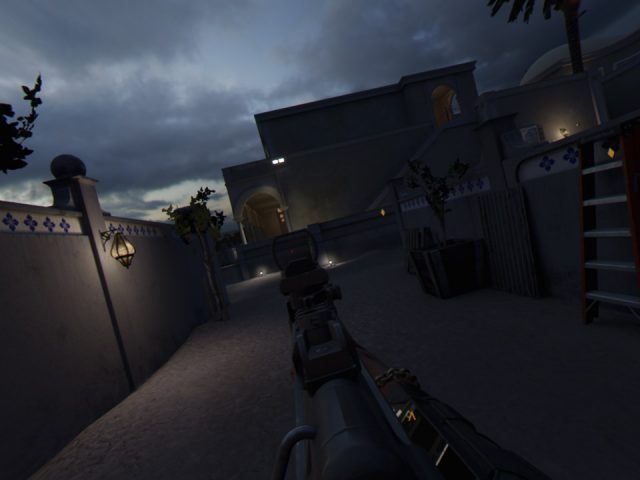
As mentioned above, movement is controlled with the left (front) stick, while the right (rear) stick is used for snap turning (which can be toggled in favor of smooth turning). A subtle vignetting option is enabled by default during sprinting and turning, but you can disable this if you’d like. I played the game primarily standing, and found the default options and movement speed to be comfortable throughout. I haven’t felt any hints of nausea while playing.
Movement direction is based on both the stick and the position of your gun; you move fastest with the stick in the 12 o’clock position, but the direction of your gun dictates the player’s ‘forward’ position. Unfortunately this makes things a little awkward, as it’s most comfortable to hold the Aim controller diagonally across your chest while not actively aiming, but that means that pushing the thumbstick to 12 o’clock will actually move you diagonally. If you counter the position of the gun by moving the thumbstick to 10 o’clock or so, the game thinks you are facing in the direction of your gun while strafing in the direction of your stick, even though it feels like ‘forward’ to you. This wouldn’t be an issue except that strafing is slower than moving forward, so when you want to be moving at top speed, you need to constantly manage the gun’s position in addition to the stick, which can be cumbersome and detract from immersion. This isn’t an issue when playing with the PS4 gamepad, since it’s most comfortable position is always facing straight forward.
Firewall Zero Hour does support the PS4 gamepad, but as mentioned it feels like it was really built for the Aim controller. Even though the PS4 gamepad gives the player tracked weapon movement, just like Aim, it’s fundamentally not designed to be held up at eye level, and you’ll find that your hands end up in a rather awkward position (with your wrists cocked at an uncomfortable angle) when attempting to aim down sights. It’s nice that the game has PS4 gamepad support as an option, so as not to restrict the game to only Aim players, but Aim really feels like the best way to play.
Aside from aiming, Firewall Zero Hour has no natural motion-driven interactions. Reloading, opening doors, collecting ammo, etc. is all done with a button press or hold. That’s unfortunate considering Farpoint (2017) has shown a few different means of creating more natural interactions with the Aim controller, like lifting it up high and bringing it back down to change weapons, or placing the weapon model in specific positions to pick up ammo. I also would have liked to see Firewall Zero Hour steal Farpoint’s reload button (L1) which is very nicely positioned on the side of the Aim controller. Instead they kept a uniform control scheme between Aim and the PS4 gamepad, defaulting to the typical FPS reload button of Square.
When it comes to menus, everything is driven with a laser pointer interface, which isn’t immersive, but at least it’s functional. Unfortunately, even on PS4 Pro, much of the smaller menu text is blurry and a bit hard to read. It feels like the developers built and tested the menus on PC headsets of higher resolution and forgot to double check the legibility in PSVR before shipping. Hopefully this will be an easy fix post-launch.

